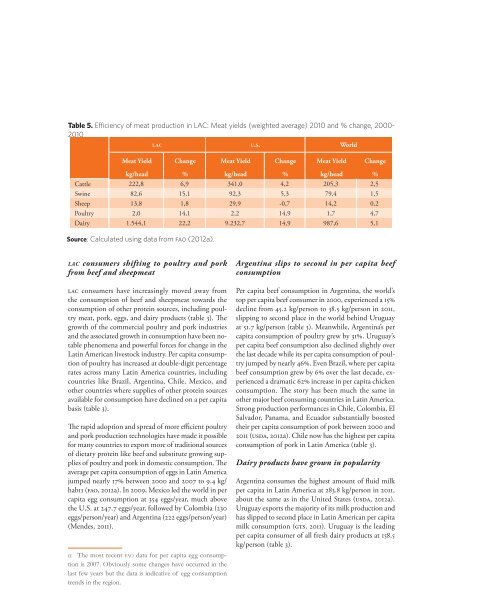1eVf8UD
1eVf8UD
1eVf8UD
You also want an ePaper? Increase the reach of your titles
YUMPU automatically turns print PDFs into web optimized ePapers that Google loves.
Table 5. Efficiency of meat production in LAC: Meat yields (weighted average) 2010 and % change, 2000-<br />
2010<br />
LAC U.S. World<br />
Meat Yield Change Meat Yield Change Meat Yield Change<br />
kg/head % kg/head % kg/head %<br />
Cattle 222,8 6,9 341,0 4,2 205,3 2,5<br />
Swine 82,6 15,1 92,3 5,3 79,4 1,5<br />
Sheep 13,8 1,8 29,9 -0,7 14,2 0,2<br />
Poultry 2,0 14,1 2,2 14,9 1,7 4,7<br />
Dairy 1.544,1 22,2 9.232,7 14,9 987,6 5,1<br />
Source: Calculated using data from fao (2012a).<br />
LAC consumers shifting to poultry and pork<br />
from beef and sheepmeat<br />
lac consumers have increasingly moved away from<br />
the consumption of beef and sheepmeat towards the<br />
consumption of other protein sources, including poultry<br />
meat, pork, eggs, and dairy products (table 3). The<br />
growth of the commercial poultry and pork industries<br />
and the associated growth in consumption have been notable<br />
phenomena and powerful forces for change in the<br />
Latin American livestock industry. Per capita consumption<br />
of poultry has increased at double-digit percentage<br />
rates across many Latin America countries, including<br />
countries like Brazil, Argentina, Chile, Mexico, and<br />
other countries where supplies of other protein sources<br />
available for consumption have declined on a per capita<br />
basis (table 3).<br />
The rapid adoption and spread of more efficient poultry<br />
and pork production technologies have made it possible<br />
for many countries to export more of traditional sources<br />
of dietary protein like beef and substitute growing supplies<br />
of poultry and pork in domestic consumption. The<br />
average per capita consumption of eggs in Latin America<br />
jumped nearly 17% between 2000 and 2007 to 9.4 kg/<br />
hab11 (fao, 2012a). In 2009, Mexico led the world in per<br />
capita egg consumption at 354 eggs/year, much above<br />
the U.S. at 247.7 eggs/year, followed by Colombia (230<br />
eggs/person/year) and Argentina (222 eggs/person/year)<br />
(Mendes, 2011).<br />
11 The most recent FAO data for per capita egg consumption<br />
is 2007. Obviously some changes have occurred in the<br />
last few years but the data is indicative of egg consumption<br />
trends in the region.<br />
Argentina slips to second in per capita beef<br />
consumption<br />
Per capita beef consumption in Argentina, the world’s<br />
top per capita beef consumer in 2000, experienced a 15%<br />
decline from 45.2 kg/person to 38.5 kg/person in 2011,<br />
slipping to second place in the world behind Uruguay<br />
at 51.7 kg/person (table 3). Meanwhile, Argentina’s per<br />
capita consumption of poultry grew by 31%. Uruguay’s<br />
per capita beef consumption also declined slightly over<br />
the last decade while its per capita consumption of poultry<br />
jumped by nearly 46%. Even Brazil, where per capita<br />
beef consumption grew by 6% over the last decade, experienced<br />
a dramatic 62% increase in per capita chicken<br />
consumption. The story has been much the same in<br />
other major beef consuming countries in Latin America.<br />
Strong production performances in Chile, Colombia, El<br />
Salvador, Panama, and Ecuador substantially boosted<br />
their per capita consumption of pork between 2000 and<br />
2011 (usda, 2012a). Chile now has the highest per capita<br />
consumption of pork in Latin America (table 3).<br />
Dairy products have grown in popularity<br />
Argentina consumes the highest amount of fluid milk<br />
per capita in Latin America at 283.8 kg/person in 2011,<br />
about the same as in the United States (usda, 2012a).<br />
Uruguay exports the majority of its milk production and<br />
has slipped to second place in Latin American per capita<br />
milk consumption (gts, 2011). Uruguay is the leading<br />
per capita consumer of all fresh dairy products at 158.5<br />
kg/person (table 3).<br />
A Perspective on Latin America and the Caribbean<br />
55


